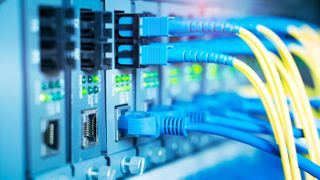Japan achieves staggering 402 Tb/s data rate with commercial optical fiber — record-breaking performance tapped into unused wavelength bands
New record shows potential high data throughput with no upgrade for current fiber optic infrastructure

Japan's National Institute of Information and Communications Technology, in association with other institutes, set a 402 Tb/s data transfer record over commercially available optical fiber cables. A paper detailing this achievement was presented at the Optical Fiber Communication Conference 2024, held in San Diego. The paper also credits the Aston Institute of Photonic Technologies and Nokia Bell Labs for contributing to this feat.
The NICT and its partners were able to transmit signals through 1,505 channels over 50 km (about 31 miles) of optic fiber cable for this experiment. It used six types of amplifiers and an optical gain equalizer that taps into the unused 37 THz bandwidth to enable the 402 Tb/s transfer speed. One of the amplifiers this was demonstrated with is a thulium-based doped fiber amplifier, which uses C-band or C+L band systems. Additionally, semiconductor optical amplifiers and Raman amplifiers were used, which achieved 256 Tb/s data rate through almost 20 THz. Other amplifiers were also used for this exercise which provided a cumulative bandwidth of 25 THz for up to 119 Tb/s data rate.
As a result, its maximum achievable result surpassed the previous data rate capacity by over 25 percent and increased transmission bandwidth by 35 percent. This is achievable with currently available technology used by internet service providers. While it shows the untapped potential of current technology, the findings indicate a potentially longer lifespan of current technology but also the comfort of expanding fiber optic deployment with new generational optical cables and systems.

This demonstration also shows that the currently used wavelength division multiplexed technology (WMD) can cover all major transmissions and provide these speeds using unexplored bands.
While researchers regularly break world records to achieve the highest possible data speed over optic fiber, new types of cables that use multiple optic fibers and new hardware are required. Having such major upgrades deployed will be an unfeasible option for many nationwide providers, let alone for regional and local service providers who are yet to move away from copper-based cables. Using multi-fiber cables also would lead to thicker cables and higher manufacturing costs.
With "beyond 5G" potential speeds achievable through commercially available cables, it will likely further a new generation of internet services. Research conducted by organizations like NICT will continue developing new amplifying methods and components while researching new wideband and its compatibility with currently deployed infrastructure.
Stay On the Cutting Edge: Get the Tom's Hardware Newsletter
Get Tom's Hardware's best news and in-depth reviews, straight to your inbox.

Roshan Ashraf Shaikh has been in the Indian PC hardware community since the early 2000s and has been building PCs, contributing to many Indian tech forums, & blogs. He operated Hardware BBQ for 11 years and wrote news for eTeknix & TweakTown before joining Tom's Hardware team. Besides tech, he is interested in fighting games, movies, anime, and mechanical watches.
-
OLDKnerd I am shooting for getting 2.5 gbit when i move to a new apartment, some do offer 5 gbit here and have done so for ages but in very small locations, and i think in / around the horrible Danish capitol, and 10 wild dragons could not drag me to that place.Reply
Been on gigabit for a few decades and really it is damn rare i see that speed realized up / down anywhere. -
USAFRet Reply
You know that is almost certainly a function of whatever server you are connecting to, right?OLDKnerd said:Been on gigabit for a few decades and really it is damn rare i see that speed realized up / down anywhere.
Moving to 2.5 can't fix that. -
OLDKnerd Yeah i know, speeds are fine within the fiber optic cable saturated Denmark, well at least for speed tests that don't really move a whole lot of data.Reply
I have never really tried to find some fast server here that would maybe offer me the full speeds, CUZ i don't do much but survive / try not to go totally insane in Denmark, actually been a while since i stopped thinking in Danish, which some times lead me to have funny conversations here as i try to find the Danish word for the English in my brain.
Worst of all if i get really pissed i change to German for a slew of insults and foul words, and if i don't calm down, well i move on to my limited vocabulary in Japanese which is a excellent language for swearing, unlike what the Merovingian in the Matrix movies feel about the French language.
Also speak a little French but Cest tres petit i think its written. -
usertests Reply
2.5 GbE works with Cat 5e cables, and the ports are becoming easy to find (I see them on Intel N100 boxes), so it's a good target for future proofing even if it is not helping with your connection to a remote server today.USAFRet said:You know that is almost certainly a function of whatever server you are connecting to, right?
Moving to 2.5 can't fix that.